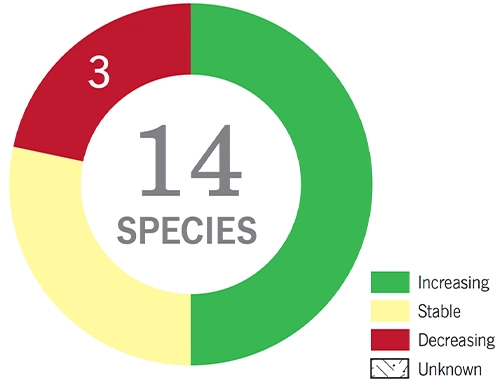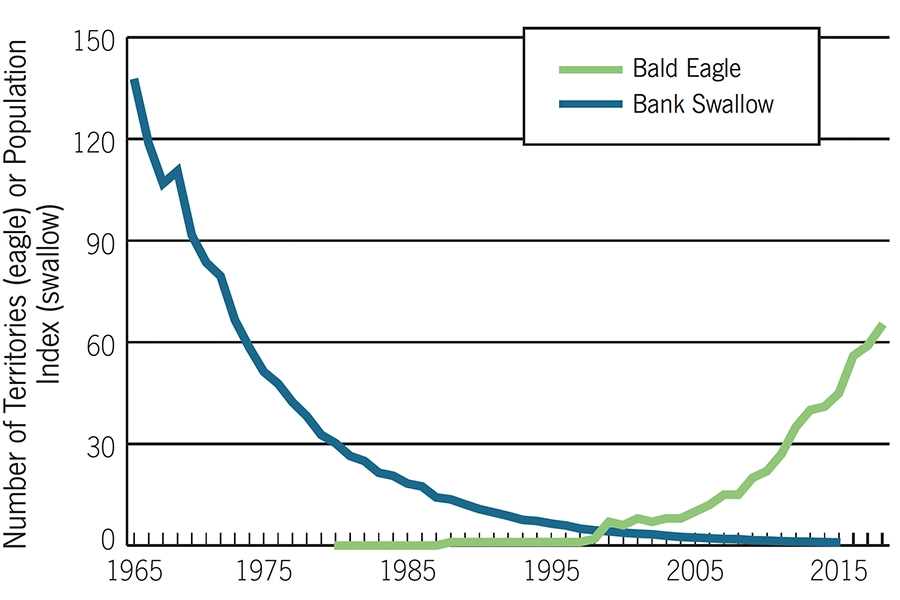Unlike other habitats discussed so far, this one is more about proximity to open water than vegetation. The birds included here, in contrast to those associated with the Marsh and Shrub Wetlands habitat, are generally not specific to certain plant communities. Most forage almost exclusively in or near lakes, ponds, rivers, and streams, and as a result usually nest nearby, whether in a bank, on a rocky shore, or in a shoreline tree. They are linked by their dependence on the aquatic habitat, and thus subject to factors that affect our surface waters.

Common Loon
Bald Eagle
Bank Swallow
Common Merganser
Spotted Sandpiper
Osprey
Belted Kingfisher

Most birds dependent on lakes and rivers are faring well. Proportionally more species in this group are increasing than in any other. In many cases, these increases have resulted directly from targeted conservation efforts. Osprey, Bald Eagle, Common Loon, and Canada Goose populations have all benefited from restoration work throughout their ranges. Only three species are declining, the most significant of which is the Bank Swallow (see Aerial Insectivores). The other two species are Spotted Sandpiper and Belted Kingfisher.
People recreating on lakes and rivers can disturb nesting birds, causing them to abandon their nests: the more disturbance, the more abandoned nests. Predators, such as raccoons, increase in numbers near human development and present a significant threat to nesting bids unless measures are taken to protect nests. When development reaches a certain threshold, some species, including loons and eagles, may move out.
As long-lived top predators in the food chain, birds such as loons and eagles can bioaccumulate environmental toxins that get into the water from the land or from the air. Even when they are not lethal to the birds, these toxins can significantly reduce reproductive success. Despite New Hampshire’s first in the nation ban on lead sinkers and jigs, lead poisoning from ingestion of lost or discarded fishing tackle remains the primary cause of mortality among New Hampshire’s adult loon population. In addition to lead and mercury, potential toxins include PCBs and flame retardants.
Some of the contaminants above, plus pesticide run-off from adjacent farms or lawns, have the potential to alter aquatic food webs. There is increasing concern over declines in insect populations, including in aquatic systems, and species higher on the food chain, including fish, may also be affected.
Development along lake and river shorelines can result in increased erosion, or even the loss of nesting trees for species like Bald Eagles. Efforts to reduce flooding by “hardening” river shorelines significantly reduce habitat for bank-nesting species like Belted Kingfisher and Bank Swallow, both of which are declining.
Key conservation strategies come down to individual actions, such as protecting nest sites from disturbance and outright destruction. Improved awareness, advocacy, and regulatory changes can all help these species, since we collectively are responsible for the detrimental effects of lead poisoning from lead sinkers, jigs, and shot, for disturbing nesting areas, and for destroying sensitive shoreline habitats. Leave sandy river banks unchanged for nesting Bank Swallows and kingfishers.
The data on the lethal effects of lead in loons are compelling. We need better data on the potential effects of other toxins on birds that use lakes and rivers.
Many threats faced by birds are tied to the habitats where they breed. Explore the habitats and learn more about each one’s characteristics, population trends, threats, and conservation actions.
Contact Headquarters

National Wildlife Federation Affiliate
Website By CleverLight
Information for the species profiles on this website was compiled from a combination of the sources listed below.
The Birds of New Hampshire. By Allan R. Keith and Robert B. Fox. 2013. Memoirs of the Nuttall Ornithological club No. 19.
Atlas of the Breeding Birds of New Hampshire. Carol R. Foss, ed. 1994. Arcadia Publishing Company and Audubon Society of New Hampshire
Birds of the World. Various authors and dates. Cornell Laboratory of Ornithology.
Data from the Breeding Bird Survey
Data from the Christmas Bird Count